Business Intelligence: Accounting, Ransomware, and Cyber Security
VerifiedAdded on 2020/05/28
|11
|2521
|49
Report
AI Summary
This report delves into the critical role of business intelligence (BI) within accounting, highlighting its transformative impact on financial decision-making and operational efficiency. It explores how BI tools facilitate data analysis, improve reporting, and enhance strategic planning. Furthermore, the report investigates the implications of ransomware attacks, specifically the 2017 WannaCry incident, on healthcare organizations, identifying key risk areas such as patient health, data security, and organizational reputation. It analyzes the impact of these attacks on sensitive data and operational capabilities, emphasizing the need for robust cyber security controls, including antivirus programs, updated software, firewalls, and staff training. The report underscores the importance of proactive measures to mitigate cyber threats and safeguard the integrity of healthcare services and patient information. This assignment solution is available on Desklib, a platform providing study resources for students.
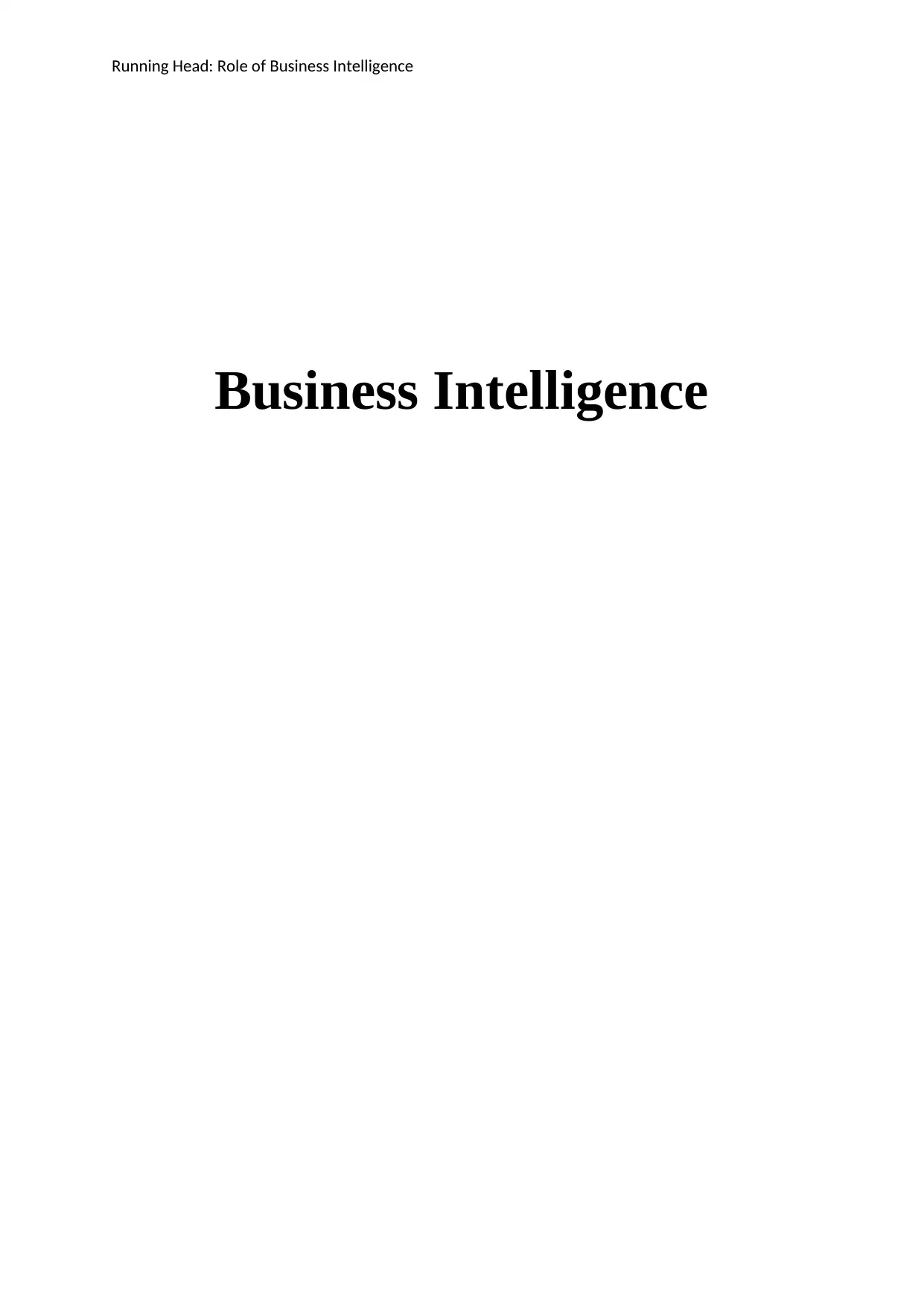
Running Head: Role of Business Intelligence
Business Intelligence
Business Intelligence
Paraphrase This Document
Need a fresh take? Get an instant paraphrase of this document with our AI Paraphraser
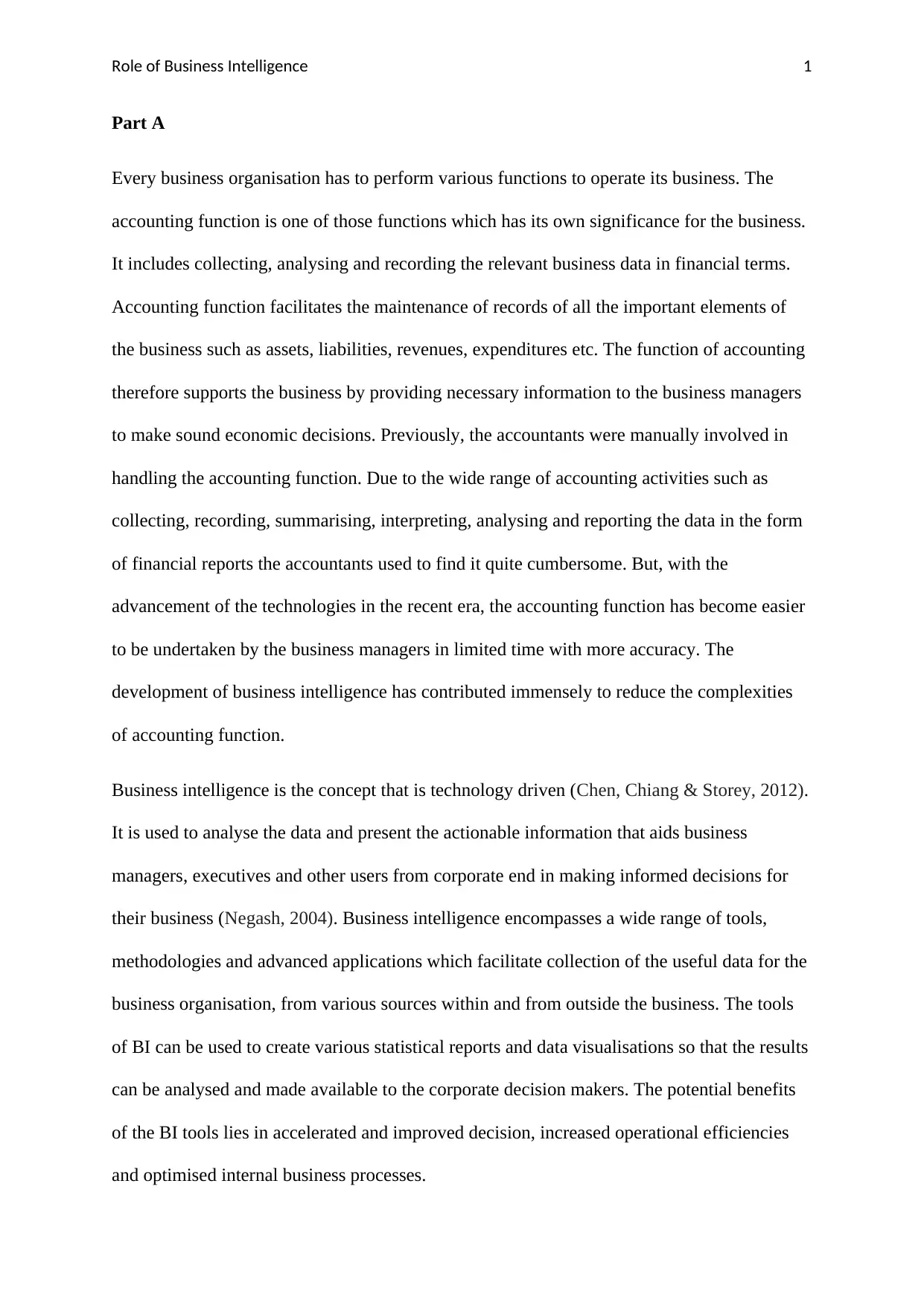
Role of Business Intelligence 1
Part A
Every business organisation has to perform various functions to operate its business. The
accounting function is one of those functions which has its own significance for the business.
It includes collecting, analysing and recording the relevant business data in financial terms.
Accounting function facilitates the maintenance of records of all the important elements of
the business such as assets, liabilities, revenues, expenditures etc. The function of accounting
therefore supports the business by providing necessary information to the business managers
to make sound economic decisions. Previously, the accountants were manually involved in
handling the accounting function. Due to the wide range of accounting activities such as
collecting, recording, summarising, interpreting, analysing and reporting the data in the form
of financial reports the accountants used to find it quite cumbersome. But, with the
advancement of the technologies in the recent era, the accounting function has become easier
to be undertaken by the business managers in limited time with more accuracy. The
development of business intelligence has contributed immensely to reduce the complexities
of accounting function.
Business intelligence is the concept that is technology driven (Chen, Chiang & Storey, 2012).
It is used to analyse the data and present the actionable information that aids business
managers, executives and other users from corporate end in making informed decisions for
their business (Negash, 2004). Business intelligence encompasses a wide range of tools,
methodologies and advanced applications which facilitate collection of the useful data for the
business organisation, from various sources within and from outside the business. The tools
of BI can be used to create various statistical reports and data visualisations so that the results
can be analysed and made available to the corporate decision makers. The potential benefits
of the BI tools lies in accelerated and improved decision, increased operational efficiencies
and optimised internal business processes.
Part A
Every business organisation has to perform various functions to operate its business. The
accounting function is one of those functions which has its own significance for the business.
It includes collecting, analysing and recording the relevant business data in financial terms.
Accounting function facilitates the maintenance of records of all the important elements of
the business such as assets, liabilities, revenues, expenditures etc. The function of accounting
therefore supports the business by providing necessary information to the business managers
to make sound economic decisions. Previously, the accountants were manually involved in
handling the accounting function. Due to the wide range of accounting activities such as
collecting, recording, summarising, interpreting, analysing and reporting the data in the form
of financial reports the accountants used to find it quite cumbersome. But, with the
advancement of the technologies in the recent era, the accounting function has become easier
to be undertaken by the business managers in limited time with more accuracy. The
development of business intelligence has contributed immensely to reduce the complexities
of accounting function.
Business intelligence is the concept that is technology driven (Chen, Chiang & Storey, 2012).
It is used to analyse the data and present the actionable information that aids business
managers, executives and other users from corporate end in making informed decisions for
their business (Negash, 2004). Business intelligence encompasses a wide range of tools,
methodologies and advanced applications which facilitate collection of the useful data for the
business organisation, from various sources within and from outside the business. The tools
of BI can be used to create various statistical reports and data visualisations so that the results
can be analysed and made available to the corporate decision makers. The potential benefits
of the BI tools lies in accelerated and improved decision, increased operational efficiencies
and optimised internal business processes.
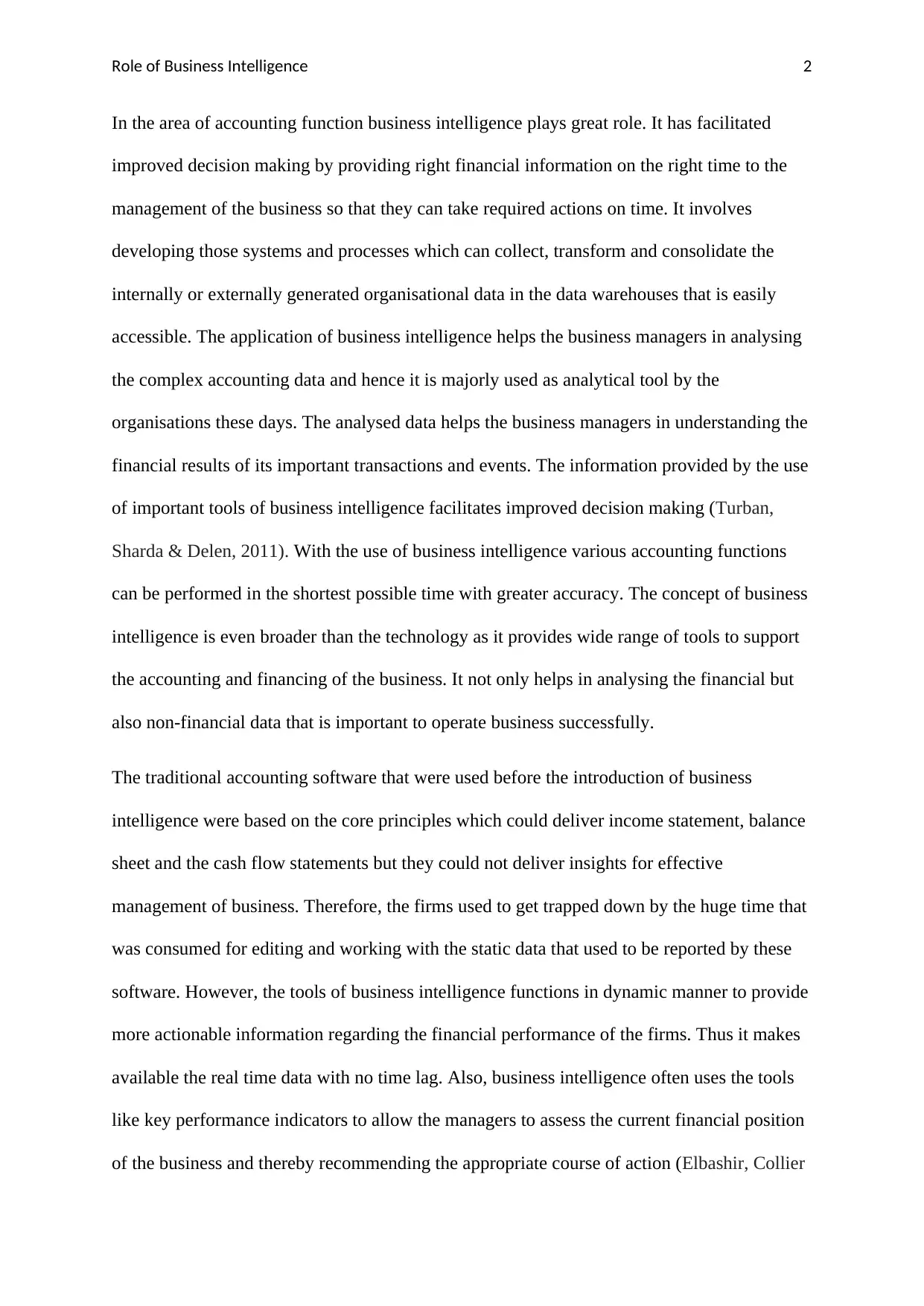
Role of Business Intelligence 2
In the area of accounting function business intelligence plays great role. It has facilitated
improved decision making by providing right financial information on the right time to the
management of the business so that they can take required actions on time. It involves
developing those systems and processes which can collect, transform and consolidate the
internally or externally generated organisational data in the data warehouses that is easily
accessible. The application of business intelligence helps the business managers in analysing
the complex accounting data and hence it is majorly used as analytical tool by the
organisations these days. The analysed data helps the business managers in understanding the
financial results of its important transactions and events. The information provided by the use
of important tools of business intelligence facilitates improved decision making (Turban,
Sharda & Delen, 2011). With the use of business intelligence various accounting functions
can be performed in the shortest possible time with greater accuracy. The concept of business
intelligence is even broader than the technology as it provides wide range of tools to support
the accounting and financing of the business. It not only helps in analysing the financial but
also non-financial data that is important to operate business successfully.
The traditional accounting software that were used before the introduction of business
intelligence were based on the core principles which could deliver income statement, balance
sheet and the cash flow statements but they could not deliver insights for effective
management of business. Therefore, the firms used to get trapped down by the huge time that
was consumed for editing and working with the static data that used to be reported by these
software. However, the tools of business intelligence functions in dynamic manner to provide
more actionable information regarding the financial performance of the firms. Thus it makes
available the real time data with no time lag. Also, business intelligence often uses the tools
like key performance indicators to allow the managers to assess the current financial position
of the business and thereby recommending the appropriate course of action (Elbashir, Collier
In the area of accounting function business intelligence plays great role. It has facilitated
improved decision making by providing right financial information on the right time to the
management of the business so that they can take required actions on time. It involves
developing those systems and processes which can collect, transform and consolidate the
internally or externally generated organisational data in the data warehouses that is easily
accessible. The application of business intelligence helps the business managers in analysing
the complex accounting data and hence it is majorly used as analytical tool by the
organisations these days. The analysed data helps the business managers in understanding the
financial results of its important transactions and events. The information provided by the use
of important tools of business intelligence facilitates improved decision making (Turban,
Sharda & Delen, 2011). With the use of business intelligence various accounting functions
can be performed in the shortest possible time with greater accuracy. The concept of business
intelligence is even broader than the technology as it provides wide range of tools to support
the accounting and financing of the business. It not only helps in analysing the financial but
also non-financial data that is important to operate business successfully.
The traditional accounting software that were used before the introduction of business
intelligence were based on the core principles which could deliver income statement, balance
sheet and the cash flow statements but they could not deliver insights for effective
management of business. Therefore, the firms used to get trapped down by the huge time that
was consumed for editing and working with the static data that used to be reported by these
software. However, the tools of business intelligence functions in dynamic manner to provide
more actionable information regarding the financial performance of the firms. Thus it makes
available the real time data with no time lag. Also, business intelligence often uses the tools
like key performance indicators to allow the managers to assess the current financial position
of the business and thereby recommending the appropriate course of action (Elbashir, Collier
⊘ This is a preview!⊘
Do you want full access?
Subscribe today to unlock all pages.

Trusted by 1+ million students worldwide
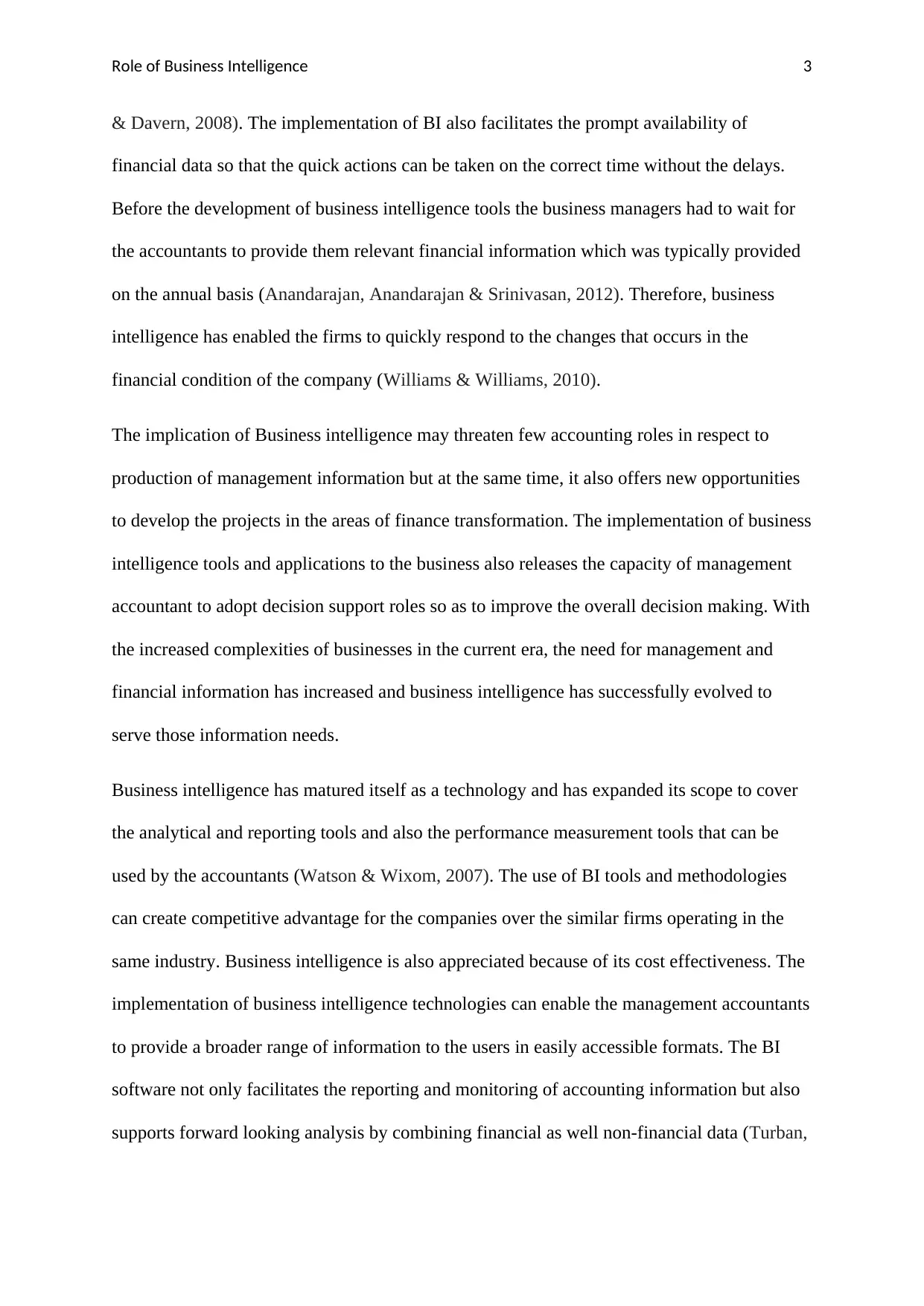
Role of Business Intelligence 3
& Davern, 2008). The implementation of BI also facilitates the prompt availability of
financial data so that the quick actions can be taken on the correct time without the delays.
Before the development of business intelligence tools the business managers had to wait for
the accountants to provide them relevant financial information which was typically provided
on the annual basis (Anandarajan, Anandarajan & Srinivasan, 2012). Therefore, business
intelligence has enabled the firms to quickly respond to the changes that occurs in the
financial condition of the company (Williams & Williams, 2010).
The implication of Business intelligence may threaten few accounting roles in respect to
production of management information but at the same time, it also offers new opportunities
to develop the projects in the areas of finance transformation. The implementation of business
intelligence tools and applications to the business also releases the capacity of management
accountant to adopt decision support roles so as to improve the overall decision making. With
the increased complexities of businesses in the current era, the need for management and
financial information has increased and business intelligence has successfully evolved to
serve those information needs.
Business intelligence has matured itself as a technology and has expanded its scope to cover
the analytical and reporting tools and also the performance measurement tools that can be
used by the accountants (Watson & Wixom, 2007). The use of BI tools and methodologies
can create competitive advantage for the companies over the similar firms operating in the
same industry. Business intelligence is also appreciated because of its cost effectiveness. The
implementation of business intelligence technologies can enable the management accountants
to provide a broader range of information to the users in easily accessible formats. The BI
software not only facilitates the reporting and monitoring of accounting information but also
supports forward looking analysis by combining financial as well non-financial data (Turban,
& Davern, 2008). The implementation of BI also facilitates the prompt availability of
financial data so that the quick actions can be taken on the correct time without the delays.
Before the development of business intelligence tools the business managers had to wait for
the accountants to provide them relevant financial information which was typically provided
on the annual basis (Anandarajan, Anandarajan & Srinivasan, 2012). Therefore, business
intelligence has enabled the firms to quickly respond to the changes that occurs in the
financial condition of the company (Williams & Williams, 2010).
The implication of Business intelligence may threaten few accounting roles in respect to
production of management information but at the same time, it also offers new opportunities
to develop the projects in the areas of finance transformation. The implementation of business
intelligence tools and applications to the business also releases the capacity of management
accountant to adopt decision support roles so as to improve the overall decision making. With
the increased complexities of businesses in the current era, the need for management and
financial information has increased and business intelligence has successfully evolved to
serve those information needs.
Business intelligence has matured itself as a technology and has expanded its scope to cover
the analytical and reporting tools and also the performance measurement tools that can be
used by the accountants (Watson & Wixom, 2007). The use of BI tools and methodologies
can create competitive advantage for the companies over the similar firms operating in the
same industry. Business intelligence is also appreciated because of its cost effectiveness. The
implementation of business intelligence technologies can enable the management accountants
to provide a broader range of information to the users in easily accessible formats. The BI
software not only facilitates the reporting and monitoring of accounting information but also
supports forward looking analysis by combining financial as well non-financial data (Turban,
Paraphrase This Document
Need a fresh take? Get an instant paraphrase of this document with our AI Paraphraser
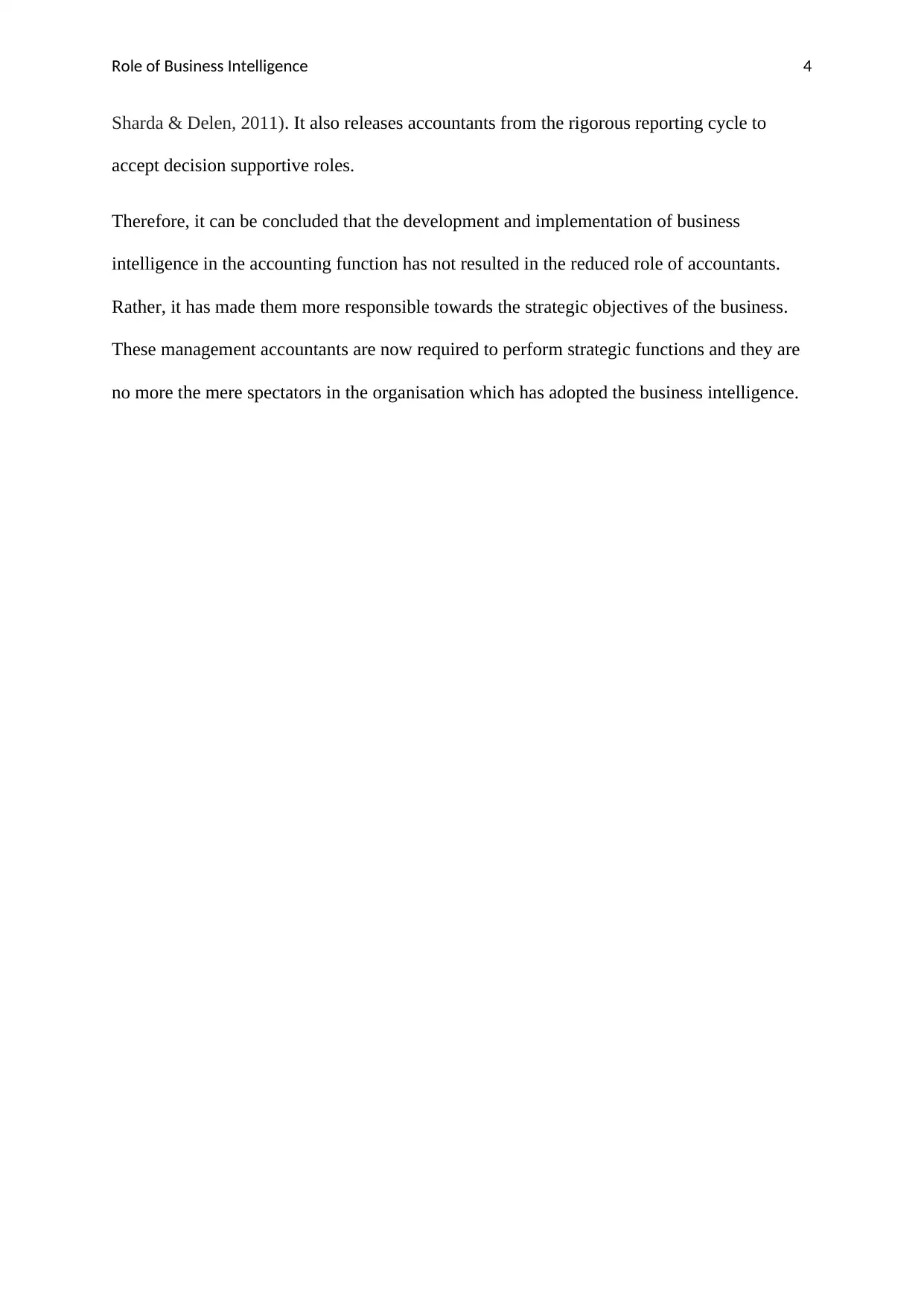
Role of Business Intelligence 4
Sharda & Delen, 2011). It also releases accountants from the rigorous reporting cycle to
accept decision supportive roles.
Therefore, it can be concluded that the development and implementation of business
intelligence in the accounting function has not resulted in the reduced role of accountants.
Rather, it has made them more responsible towards the strategic objectives of the business.
These management accountants are now required to perform strategic functions and they are
no more the mere spectators in the organisation which has adopted the business intelligence.
Sharda & Delen, 2011). It also releases accountants from the rigorous reporting cycle to
accept decision supportive roles.
Therefore, it can be concluded that the development and implementation of business
intelligence in the accounting function has not resulted in the reduced role of accountants.
Rather, it has made them more responsible towards the strategic objectives of the business.
These management accountants are now required to perform strategic functions and they are
no more the mere spectators in the organisation which has adopted the business intelligence.
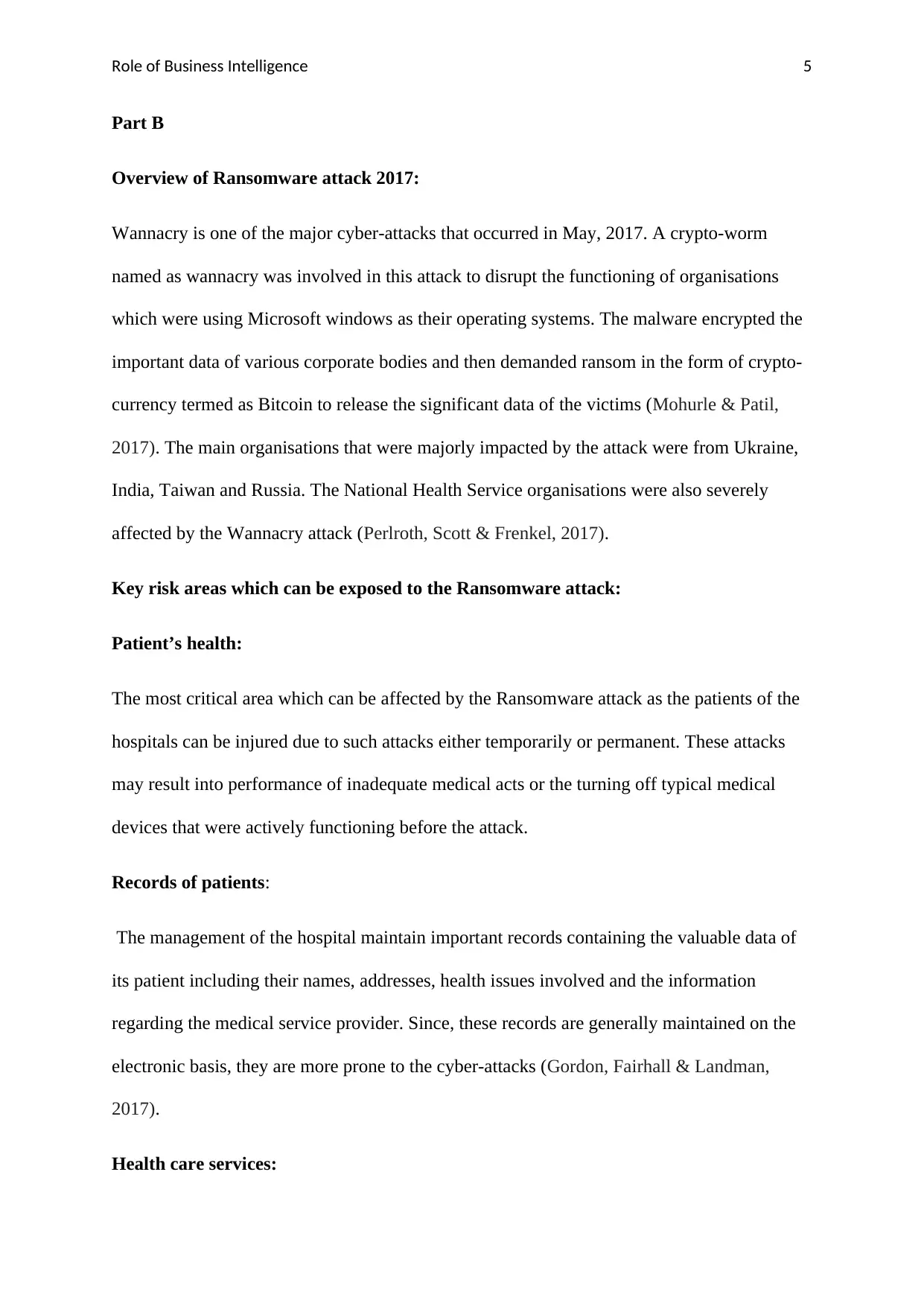
Role of Business Intelligence 5
Part B
Overview of Ransomware attack 2017:
Wannacry is one of the major cyber-attacks that occurred in May, 2017. A crypto-worm
named as wannacry was involved in this attack to disrupt the functioning of organisations
which were using Microsoft windows as their operating systems. The malware encrypted the
important data of various corporate bodies and then demanded ransom in the form of crypto-
currency termed as Bitcoin to release the significant data of the victims (Mohurle & Patil,
2017). The main organisations that were majorly impacted by the attack were from Ukraine,
India, Taiwan and Russia. The National Health Service organisations were also severely
affected by the Wannacry attack (Perlroth, Scott & Frenkel, 2017).
Key risk areas which can be exposed to the Ransomware attack:
Patient’s health:
The most critical area which can be affected by the Ransomware attack as the patients of the
hospitals can be injured due to such attacks either temporarily or permanent. These attacks
may result into performance of inadequate medical acts or the turning off typical medical
devices that were actively functioning before the attack.
Records of patients:
The management of the hospital maintain important records containing the valuable data of
its patient including their names, addresses, health issues involved and the information
regarding the medical service provider. Since, these records are generally maintained on the
electronic basis, they are more prone to the cyber-attacks (Gordon, Fairhall & Landman,
2017).
Health care services:
Part B
Overview of Ransomware attack 2017:
Wannacry is one of the major cyber-attacks that occurred in May, 2017. A crypto-worm
named as wannacry was involved in this attack to disrupt the functioning of organisations
which were using Microsoft windows as their operating systems. The malware encrypted the
important data of various corporate bodies and then demanded ransom in the form of crypto-
currency termed as Bitcoin to release the significant data of the victims (Mohurle & Patil,
2017). The main organisations that were majorly impacted by the attack were from Ukraine,
India, Taiwan and Russia. The National Health Service organisations were also severely
affected by the Wannacry attack (Perlroth, Scott & Frenkel, 2017).
Key risk areas which can be exposed to the Ransomware attack:
Patient’s health:
The most critical area which can be affected by the Ransomware attack as the patients of the
hospitals can be injured due to such attacks either temporarily or permanent. These attacks
may result into performance of inadequate medical acts or the turning off typical medical
devices that were actively functioning before the attack.
Records of patients:
The management of the hospital maintain important records containing the valuable data of
its patient including their names, addresses, health issues involved and the information
regarding the medical service provider. Since, these records are generally maintained on the
electronic basis, they are more prone to the cyber-attacks (Gordon, Fairhall & Landman,
2017).
Health care services:
⊘ This is a preview!⊘
Do you want full access?
Subscribe today to unlock all pages.

Trusted by 1+ million students worldwide
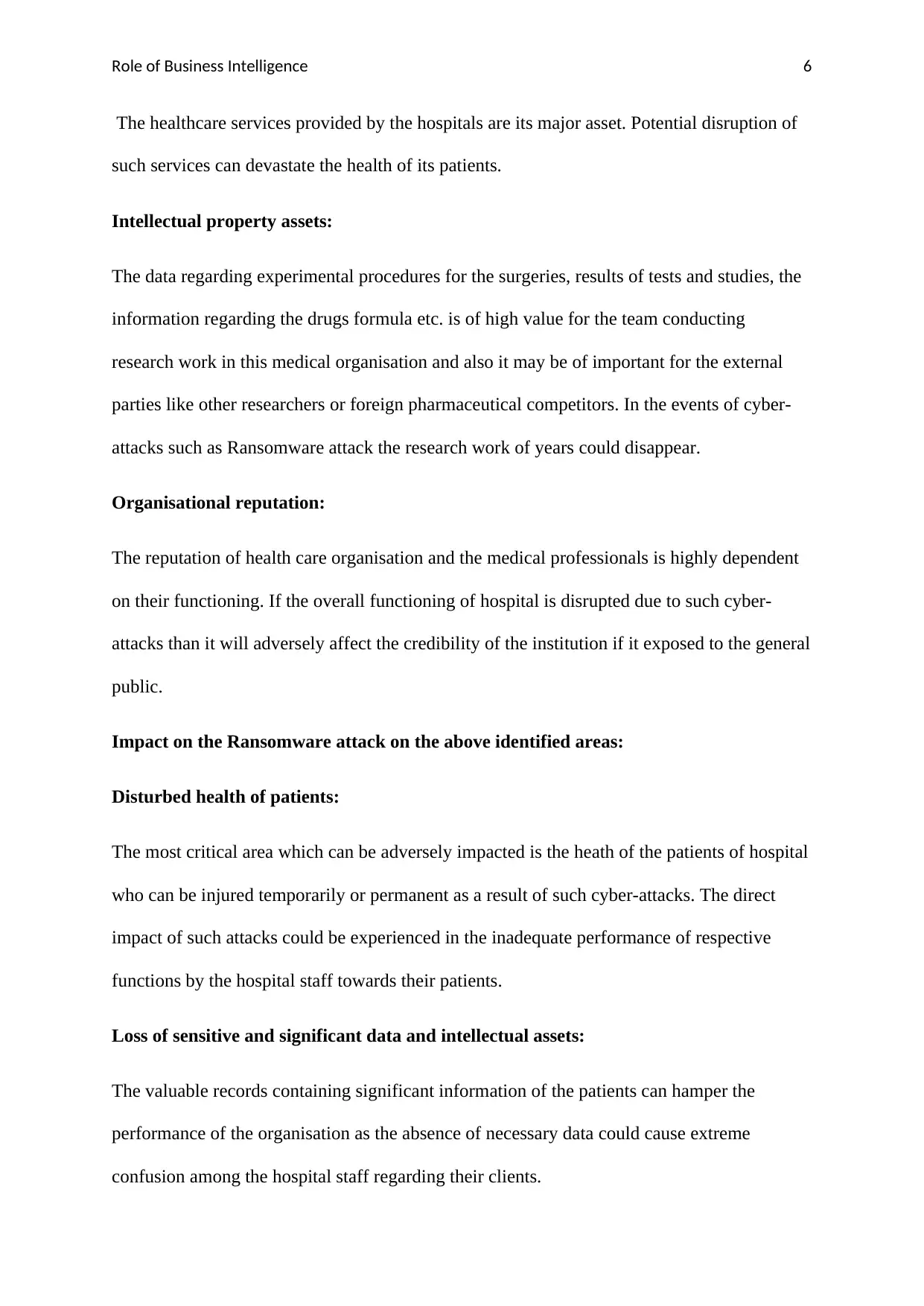
Role of Business Intelligence 6
The healthcare services provided by the hospitals are its major asset. Potential disruption of
such services can devastate the health of its patients.
Intellectual property assets:
The data regarding experimental procedures for the surgeries, results of tests and studies, the
information regarding the drugs formula etc. is of high value for the team conducting
research work in this medical organisation and also it may be of important for the external
parties like other researchers or foreign pharmaceutical competitors. In the events of cyber-
attacks such as Ransomware attack the research work of years could disappear.
Organisational reputation:
The reputation of health care organisation and the medical professionals is highly dependent
on their functioning. If the overall functioning of hospital is disrupted due to such cyber-
attacks than it will adversely affect the credibility of the institution if it exposed to the general
public.
Impact on the Ransomware attack on the above identified areas:
Disturbed health of patients:
The most critical area which can be adversely impacted is the heath of the patients of hospital
who can be injured temporarily or permanent as a result of such cyber-attacks. The direct
impact of such attacks could be experienced in the inadequate performance of respective
functions by the hospital staff towards their patients.
Loss of sensitive and significant data and intellectual assets:
The valuable records containing significant information of the patients can hamper the
performance of the organisation as the absence of necessary data could cause extreme
confusion among the hospital staff regarding their clients.
The healthcare services provided by the hospitals are its major asset. Potential disruption of
such services can devastate the health of its patients.
Intellectual property assets:
The data regarding experimental procedures for the surgeries, results of tests and studies, the
information regarding the drugs formula etc. is of high value for the team conducting
research work in this medical organisation and also it may be of important for the external
parties like other researchers or foreign pharmaceutical competitors. In the events of cyber-
attacks such as Ransomware attack the research work of years could disappear.
Organisational reputation:
The reputation of health care organisation and the medical professionals is highly dependent
on their functioning. If the overall functioning of hospital is disrupted due to such cyber-
attacks than it will adversely affect the credibility of the institution if it exposed to the general
public.
Impact on the Ransomware attack on the above identified areas:
Disturbed health of patients:
The most critical area which can be adversely impacted is the heath of the patients of hospital
who can be injured temporarily or permanent as a result of such cyber-attacks. The direct
impact of such attacks could be experienced in the inadequate performance of respective
functions by the hospital staff towards their patients.
Loss of sensitive and significant data and intellectual assets:
The valuable records containing significant information of the patients can hamper the
performance of the organisation as the absence of necessary data could cause extreme
confusion among the hospital staff regarding their clients.
Paraphrase This Document
Need a fresh take? Get an instant paraphrase of this document with our AI Paraphraser
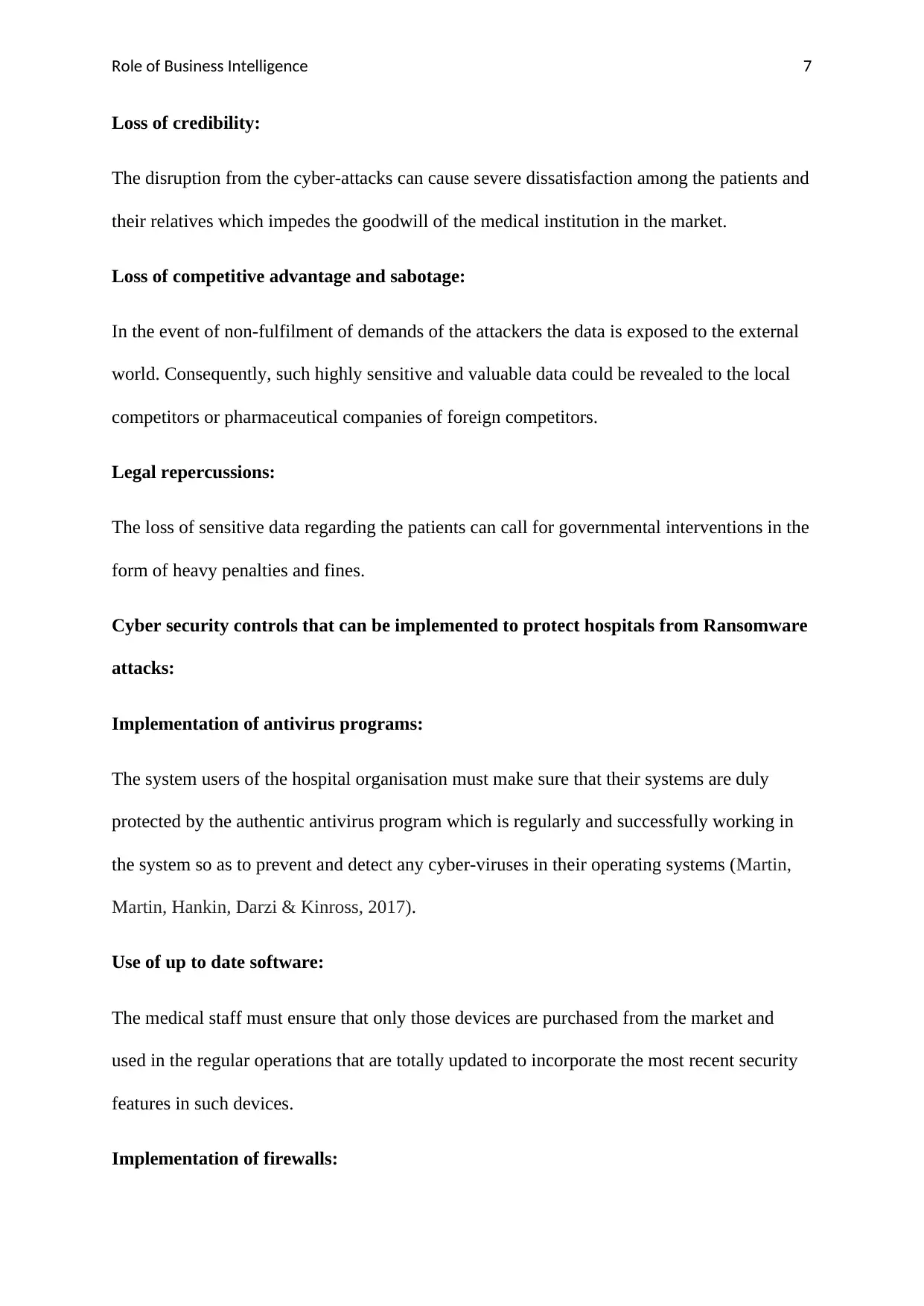
Role of Business Intelligence 7
Loss of credibility:
The disruption from the cyber-attacks can cause severe dissatisfaction among the patients and
their relatives which impedes the goodwill of the medical institution in the market.
Loss of competitive advantage and sabotage:
In the event of non-fulfilment of demands of the attackers the data is exposed to the external
world. Consequently, such highly sensitive and valuable data could be revealed to the local
competitors or pharmaceutical companies of foreign competitors.
Legal repercussions:
The loss of sensitive data regarding the patients can call for governmental interventions in the
form of heavy penalties and fines.
Cyber security controls that can be implemented to protect hospitals from Ransomware
attacks:
Implementation of antivirus programs:
The system users of the hospital organisation must make sure that their systems are duly
protected by the authentic antivirus program which is regularly and successfully working in
the system so as to prevent and detect any cyber-viruses in their operating systems (Martin,
Martin, Hankin, Darzi & Kinross, 2017).
Use of up to date software:
The medical staff must ensure that only those devices are purchased from the market and
used in the regular operations that are totally updated to incorporate the most recent security
features in such devices.
Implementation of firewalls:
Loss of credibility:
The disruption from the cyber-attacks can cause severe dissatisfaction among the patients and
their relatives which impedes the goodwill of the medical institution in the market.
Loss of competitive advantage and sabotage:
In the event of non-fulfilment of demands of the attackers the data is exposed to the external
world. Consequently, such highly sensitive and valuable data could be revealed to the local
competitors or pharmaceutical companies of foreign competitors.
Legal repercussions:
The loss of sensitive data regarding the patients can call for governmental interventions in the
form of heavy penalties and fines.
Cyber security controls that can be implemented to protect hospitals from Ransomware
attacks:
Implementation of antivirus programs:
The system users of the hospital organisation must make sure that their systems are duly
protected by the authentic antivirus program which is regularly and successfully working in
the system so as to prevent and detect any cyber-viruses in their operating systems (Martin,
Martin, Hankin, Darzi & Kinross, 2017).
Use of up to date software:
The medical staff must ensure that only those devices are purchased from the market and
used in the regular operations that are totally updated to incorporate the most recent security
features in such devices.
Implementation of firewalls:
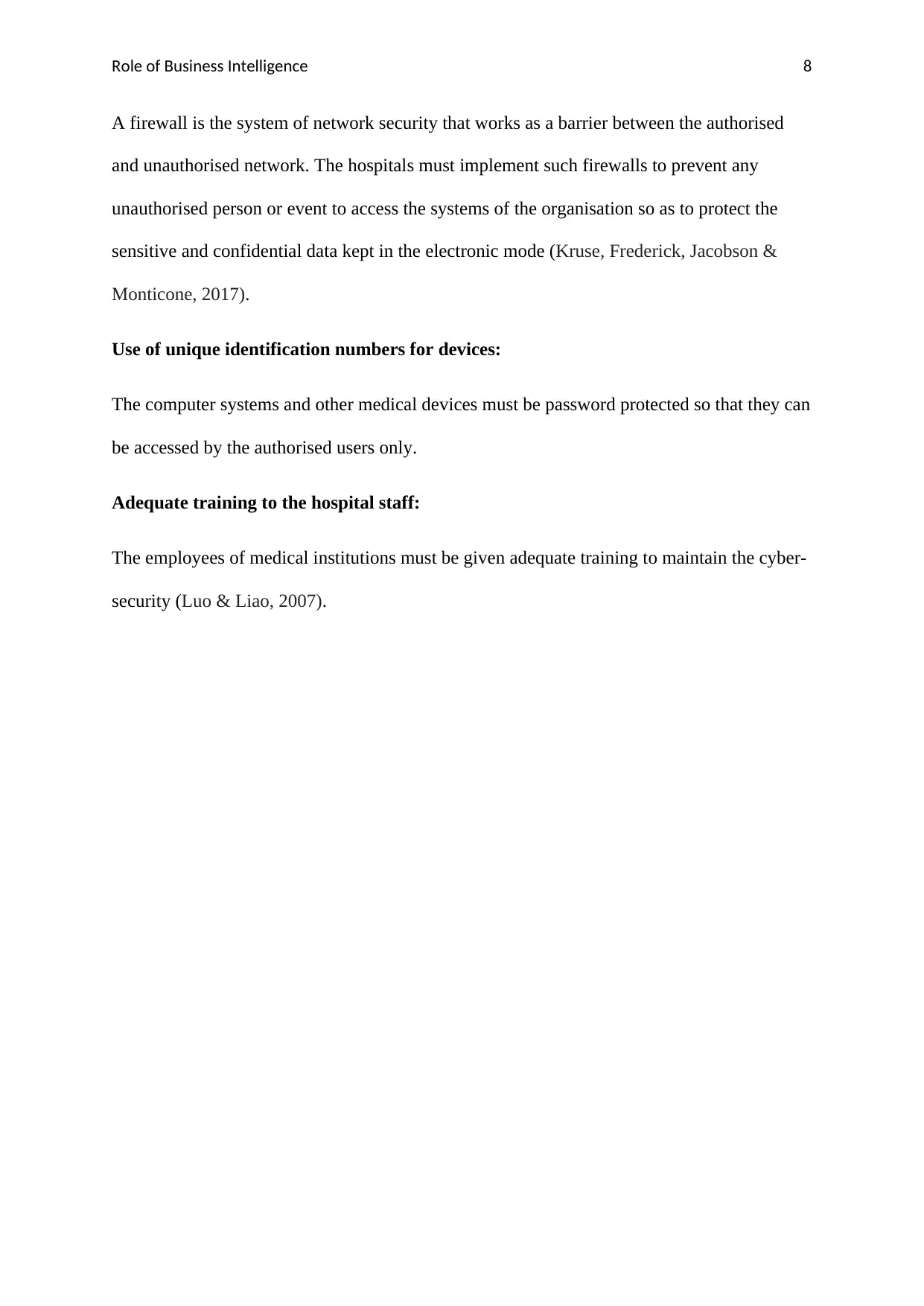
Role of Business Intelligence 8
A firewall is the system of network security that works as a barrier between the authorised
and unauthorised network. The hospitals must implement such firewalls to prevent any
unauthorised person or event to access the systems of the organisation so as to protect the
sensitive and confidential data kept in the electronic mode (Kruse, Frederick, Jacobson &
Monticone, 2017).
Use of unique identification numbers for devices:
The computer systems and other medical devices must be password protected so that they can
be accessed by the authorised users only.
Adequate training to the hospital staff:
The employees of medical institutions must be given adequate training to maintain the cyber-
security (Luo & Liao, 2007).
A firewall is the system of network security that works as a barrier between the authorised
and unauthorised network. The hospitals must implement such firewalls to prevent any
unauthorised person or event to access the systems of the organisation so as to protect the
sensitive and confidential data kept in the electronic mode (Kruse, Frederick, Jacobson &
Monticone, 2017).
Use of unique identification numbers for devices:
The computer systems and other medical devices must be password protected so that they can
be accessed by the authorised users only.
Adequate training to the hospital staff:
The employees of medical institutions must be given adequate training to maintain the cyber-
security (Luo & Liao, 2007).
⊘ This is a preview!⊘
Do you want full access?
Subscribe today to unlock all pages.

Trusted by 1+ million students worldwide
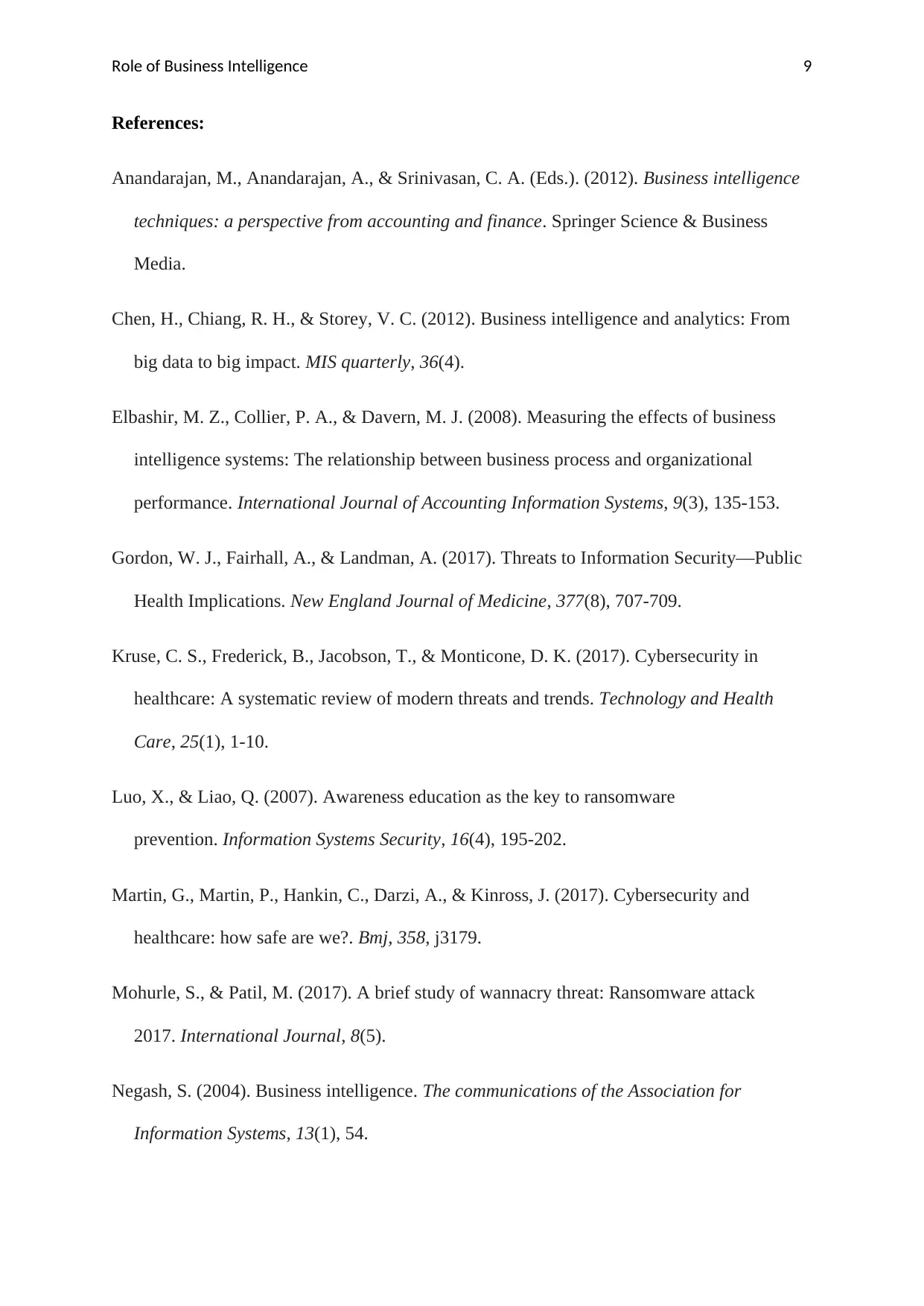
Role of Business Intelligence 9
References:
Anandarajan, M., Anandarajan, A., & Srinivasan, C. A. (Eds.). (2012). Business intelligence
techniques: a perspective from accounting and finance. Springer Science & Business
Media.
Chen, H., Chiang, R. H., & Storey, V. C. (2012). Business intelligence and analytics: From
big data to big impact. MIS quarterly, 36(4).
Elbashir, M. Z., Collier, P. A., & Davern, M. J. (2008). Measuring the effects of business
intelligence systems: The relationship between business process and organizational
performance. International Journal of Accounting Information Systems, 9(3), 135-153.
Gordon, W. J., Fairhall, A., & Landman, A. (2017). Threats to Information Security—Public
Health Implications. New England Journal of Medicine, 377(8), 707-709.
Kruse, C. S., Frederick, B., Jacobson, T., & Monticone, D. K. (2017). Cybersecurity in
healthcare: A systematic review of modern threats and trends. Technology and Health
Care, 25(1), 1-10.
Luo, X., & Liao, Q. (2007). Awareness education as the key to ransomware
prevention. Information Systems Security, 16(4), 195-202.
Martin, G., Martin, P., Hankin, C., Darzi, A., & Kinross, J. (2017). Cybersecurity and
healthcare: how safe are we?. Bmj, 358, j3179.
Mohurle, S., & Patil, M. (2017). A brief study of wannacry threat: Ransomware attack
2017. International Journal, 8(5).
Negash, S. (2004). Business intelligence. The communications of the Association for
Information Systems, 13(1), 54.
References:
Anandarajan, M., Anandarajan, A., & Srinivasan, C. A. (Eds.). (2012). Business intelligence
techniques: a perspective from accounting and finance. Springer Science & Business
Media.
Chen, H., Chiang, R. H., & Storey, V. C. (2012). Business intelligence and analytics: From
big data to big impact. MIS quarterly, 36(4).
Elbashir, M. Z., Collier, P. A., & Davern, M. J. (2008). Measuring the effects of business
intelligence systems: The relationship between business process and organizational
performance. International Journal of Accounting Information Systems, 9(3), 135-153.
Gordon, W. J., Fairhall, A., & Landman, A. (2017). Threats to Information Security—Public
Health Implications. New England Journal of Medicine, 377(8), 707-709.
Kruse, C. S., Frederick, B., Jacobson, T., & Monticone, D. K. (2017). Cybersecurity in
healthcare: A systematic review of modern threats and trends. Technology and Health
Care, 25(1), 1-10.
Luo, X., & Liao, Q. (2007). Awareness education as the key to ransomware
prevention. Information Systems Security, 16(4), 195-202.
Martin, G., Martin, P., Hankin, C., Darzi, A., & Kinross, J. (2017). Cybersecurity and
healthcare: how safe are we?. Bmj, 358, j3179.
Mohurle, S., & Patil, M. (2017). A brief study of wannacry threat: Ransomware attack
2017. International Journal, 8(5).
Negash, S. (2004). Business intelligence. The communications of the Association for
Information Systems, 13(1), 54.
Paraphrase This Document
Need a fresh take? Get an instant paraphrase of this document with our AI Paraphraser
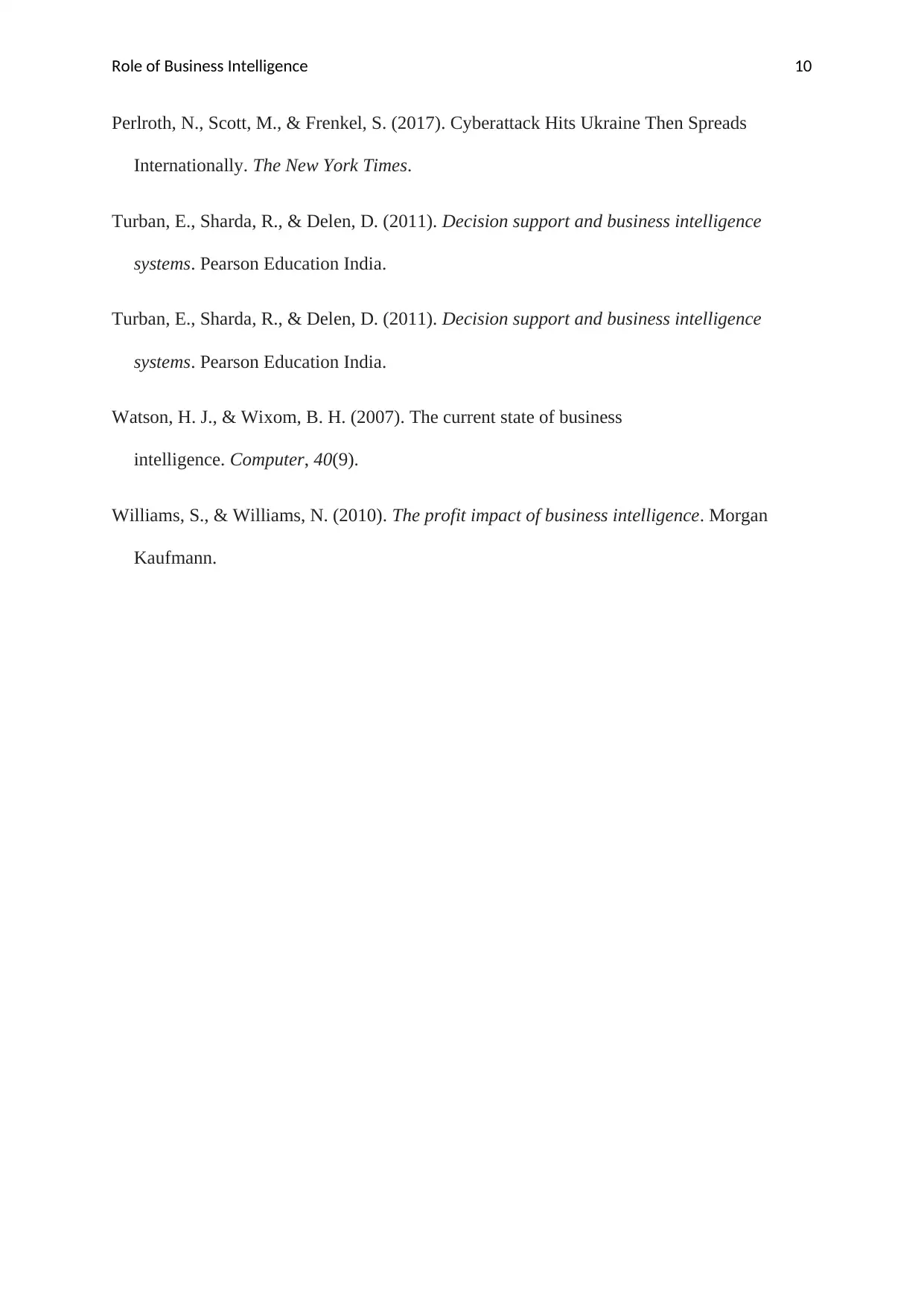
Role of Business Intelligence 10
Perlroth, N., Scott, M., & Frenkel, S. (2017). Cyberattack Hits Ukraine Then Spreads
Internationally. The New York Times.
Turban, E., Sharda, R., & Delen, D. (2011). Decision support and business intelligence
systems. Pearson Education India.
Turban, E., Sharda, R., & Delen, D. (2011). Decision support and business intelligence
systems. Pearson Education India.
Watson, H. J., & Wixom, B. H. (2007). The current state of business
intelligence. Computer, 40(9).
Williams, S., & Williams, N. (2010). The profit impact of business intelligence. Morgan
Kaufmann.
Perlroth, N., Scott, M., & Frenkel, S. (2017). Cyberattack Hits Ukraine Then Spreads
Internationally. The New York Times.
Turban, E., Sharda, R., & Delen, D. (2011). Decision support and business intelligence
systems. Pearson Education India.
Turban, E., Sharda, R., & Delen, D. (2011). Decision support and business intelligence
systems. Pearson Education India.
Watson, H. J., & Wixom, B. H. (2007). The current state of business
intelligence. Computer, 40(9).
Williams, S., & Williams, N. (2010). The profit impact of business intelligence. Morgan
Kaufmann.
1 out of 11
Related Documents
Your All-in-One AI-Powered Toolkit for Academic Success.
+13062052269
info@desklib.com
Available 24*7 on WhatsApp / Email
![[object Object]](/_next/static/media/star-bottom.7253800d.svg)
Unlock your academic potential
Copyright © 2020–2025 A2Z Services. All Rights Reserved. Developed and managed by ZUCOL.




